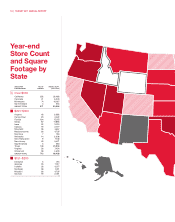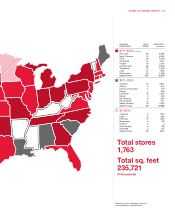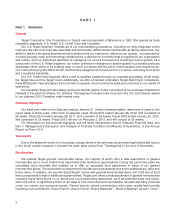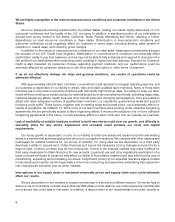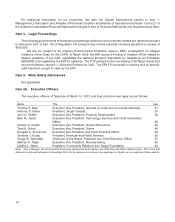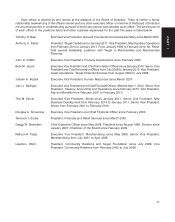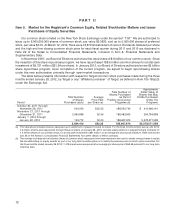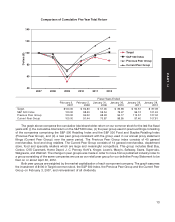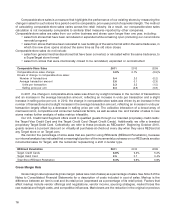Target 2011 Annual Report Download - page 30
Download and view the complete annual report
Please find page 30 of the 2011 Target annual report below. You can navigate through the pages in the report by either clicking on the pages listed below, or by using the keyword search tool below to find specific information within the annual report.We are highly susceptible to the state of macroeconomic conditions and consumer confidence in the United
States.
All of our stores are currently located within the United States, making our results highly dependent on U.S.
consumer confidence and the health of the U.S. economy. In addition, a significant portion of our total sales is
derived from stores located in five states: California, Texas, Florida, Minnesota and Illinois, resulting in further
dependence on local economic conditions in these states. Deterioration in macroeconomic conditions and
consumer confidence could negatively affect our business in many ways, including slowing sales growth or
reduction in overall sales, and reducing gross margins.
In addition to the impact of macroeconomic conditions on our retail sales, these same considerations impact
the success of our U.S. Credit Card Segment. Deterioration in macroeconomic conditions can adversely affect
cardholders’ ability to pay their balances, and we may not be able to fully anticipate and respond to changes in the
risk profile of our cardholders when extending credit, resulting in higher bad debt expense. Demand for consumer
credit is also impacted by consumer choices regarding payment methods, and our performance could be
adversely affected by consumer decisions to use third-party debit cards or other forms of payment.
If we do not effectively manage our large and growing workforce, our results of operations could be
adversely affected.
With approximately 365,000 team members, our workforce costs represent our largest operating expense, and
our business is dependent on our ability to attract, train and retain qualified team members. Many of those team
members are in entry-level or part-time positions with historically high turnover rates. Our ability to meet our labor
needs while controlling our costs is subject to external factors such as unemployment levels, prevailing wage rates,
collective bargaining efforts, health care and other benefit costs and changing demographics. If we are unable to
attract and retain adequate numbers of qualified team members, our operations, guest service levels and support
functions could suffer. Those factors, together with increasing wage and benefit costs, could adversely affect our
results of operations. As of March 15, 2012, none of our team members were working under collective bargaining
agreements. We are periodically subject to labor organizing efforts. If we become subject to one or more collective
bargaining agreements in the future, it could adversely affect our labor costs and how we operate our business.
Lack of availability of suitable locations in which to build new stores could slow our growth, and difficulty in
executing plans for new stores, expansions and remodels could increase our costs and capital
requirements.
Our future growth is dependent, in part, on our ability to build new stores and expand and remodel existing
stores in a manner that achieves appropriate returns on our capital investment. We compete with other retailers and
businesses for suitable locations for our stores. In addition, for many sites we are dependent on a third party
developer’s ability to acquire land, obtain financing and secure the necessary zoning changes and permits for a
larger project, of which our store may be one component. Turmoil in the financial markets may make it difficult for
third party developers to obtain financing for new projects. Local land use and other regulations applicable to the
types of stores we desire to construct may affect our ability to find suitable locations and also influence the cost of
constructing, expanding and remodeling our stores. A significant portion of our expected new store sites is located
in fully developed markets, which is generally a more time-consuming and expensive undertaking than expansion
into undeveloped suburban and ex-urban markets.
Interruptions in our supply chain or increased commodity prices and supply chain costs could adversely
affect our results.
We are dependent on our vendors to supply merchandise in a timely and efficient manner. If a vendor fails to
deliver on its commitments, whether due to financial difficulties or other reasons, we could experience merchandise
out-of-stocks that could lead to lost sales. In addition, a large portion of our merchandise is sourced, directly or
6


